Septic System Information & Recommendations
This page offers you helpful information and recommendations on how to properly maintain your septic system.
How A Septic Tank & Septic System Works
The septic system is a sewage treatment and disposal system. A basic system consists of a septic tank and drainage area. All flows from the house are directed by way of a main sewer line to the septic tank. 40% of household sewage is from the toilet, 30% is from bathing, 15% is from laundry, and 10% is from the kitchen.
What is a Septic Tank?
The septic tank is a watertight chamber constructed of concrete or poly material. The average size is approximately 1000 gallons to 1500 gallons in capacity. Most septic tanks have one or two compartments. Two-compartment tanks, or two single-compartment tanks in series, provide better settling of the solids.
Each septic tank has an inspection port over each baffle as well as a manhole access port. The manhole lid needs to be accessed for the tank to be pumped. These can be found at or below the ground surface. Typically you will find 4” diameter plastic lids at the ground surface that are the inspection ports over either of the baffles on the tank and not where the tank is to be pumped through.
The baffles of the tank are one of the most important components in the septic tank. The inlet baffle forces the wastewater from the sewer line down into the tank instead of across the surface of the tank and into the outlet pipe leading to the absorption area. The outlet baffle prevents the scum layer from moving into the soil absorption area. In a properly functioning septic tank, the solids and sludge settle to the bottom and accumulate, scum (lightweight materials including paper, fats, and greases) rises to the surface, and the effluent (liquid) in the tank existing between those layers overflows to the absorption area.
Septic Pump & Effluent Pump Tanks
Some systems require a pump to pump the effluent from the septic tank to the absorption area. The pump, along with float switches and electrical connections, would be located in a pump tank or dosing tank following the septic tank(s) and before the absorption area. There would also be an alarm box located in the house (usually the basement or garage) that sounds when there is a problem or malfunction with any of these components. Typically there is a reserve in the pump tank to enable water use in the house when the alarm sounds, but the issue needs to be addressed ASAP.

Misconceptions of Septic Systems
You never have to have the septic tank pumped.
As the septic system is used, the solids (sludge) accumulate on the bottom of the septic tank(s). When the sludge level increases, sewage has less time to settle properly before leaving the tank through the outlet pipe, and a greater percentage of suspended solids escape into the absorption area. If sludge accumulates too long, no settling of the solids will occur, and the solids will be able to directly enter the absorption area. These solids will clog the distribution lines and soil and cause serious and expensive problems for the homeowner. To prevent this, the tank must be pumped out on a regular basis.
If you use additives, you don’t have to have the tank pumped.
The claims made by companies that sell additives are that you never have to pump your tank. What the products do is break up the scum and sludge so that there is a greater percentage of suspended solids in the tank that then flow down the overflow pipe with the effluent to your absorption area, causing your system to fail. The absorption area is designed to treat water or effluent, not solids. The septic tank is designed to contain and treat the solids, and they should remain in the tank. It is much less costly to pump your tank on a routine basis than ultimately having to replace your absorption area.
It takes years to have the tank pumped for the septic tank to fill to its capacity.
The average usage for a family of four will fill a septic tank to its working capacity of 1000 – 1500 gallons in approximately one week. When the contents (liquids and solids) in the tank reach the level of the overflow pipe, the effluent flows down the overflow pipe to the absorption area every time water is used in the house. The tank works at this full level until it is emptied when it is pumped again.
When the alarm for the pump sounds, it means you need to pump your tank.
If you have a system designed with a pump to pump the effluent to the absorption area, you also have an alarm for the septic system. The alarm sounds when the water level rises in the pump tank and alerts you that there is a malfunction with your pump, float switches, or another component in the pump tank. It does not mean that it is time for routine pumping of your tank.
Basics of Septic System Maintenance
Good solid maintenance, along with reasonable moderate use and common sense, is of major importance to managing and maintaining most septic systems. While your septic system won’t last forever, you can prolong its life by conserving water and having your septic tank(s) routinely cleaned.
Pump your septic tank regularly. The frequency of pumping the tank or tanks is based on how many people live in the house, usage, capacity, and age for each specific system. Generally, do not allow more than two years for a family of 4 to go by without pumping the tank to keep the accumulation of solids and sludge to a minimum, preventing them from flowing to the absorption area. If the tank is not pumped routinely, the system will fail due to the increased percentage of solids and scum that have clogged the soil.
Always pump the tank through the large central manhole, not the baffle ports. This minimizes the risk of harm to the baffles and maximizes the ability to properly clean the solids from the tank. Baffles should be checked at this time, and if they are missing or damaged, they should be replaced as soon as possible. An extension, or riser, can be installed on the manhole to make it more accessible for pumping. State regulations require that the manhole cover be no deeper than 12 inches below grade.
Do not pour grease, fats, or oils from cooking down the drain, and do not use the sinks to dispose of food scraps, eggshells, or coffee grounds. Grease can cause serious and costly problems for your septic system. Garbage disposals are usually not recommended for septic systems due to the potential for significant additional solids, fats, greases, and oils being added to the system. When disposals are present, use them minimally. DO NOT dispose of petroleum-related products, paints of any type, cigarette butts, cat litter, and feminine products of any type down the drains. A septic tank is not a trashcan. NEVER put harmful products or objects into your system ~ read product labels carefully to make sure they are safe for your septic system. Chlorine and bleach products should be used sparingly.
Monitor your water consumption. Even if your tank(s) are properly cleaned routinely, you can still cause failure by hydraulically overloading it by using more water than your system was designed to handle or can handle. A septic system is designed, when it is installed, to handle a certain daily water usage based on the number of occupants proposed to be living in the home. Think water conservation! Average water usage: shower: 2.5 gallons per minute, toilet: 2 gallons per flush (for toilets bought in the last 20 years), washing machine: 40 gallons per load, dishwasher: 10 gallons. Front-loading washers use 1/3 less water than top-loading units. Large flows such as laundry should be spaced out across the week (no more than 2 loads per day is recommended) rather than running 5 or 6 loads on a single day. Only use the clothes washer and dishwasher when you have a full load. Always promptly repair leaky fixtures, faucets, and toilets. A running toilet can add as much as 200 gallons per day of flow to a septic system. Water treatment equipment/softeners should also be kept in check to minimize the number of backwash cycles per week to the least necessary to sufficiently treat the water conditions. Large whirlpool tubs should also be used with moderation since some tubs can hold close to the equivalent of an entire family's daily flow.
Chemical or biological additives are not a substitute for regular pumping. They are not needed to improve or assist tank operation. Additive producers claim these products eliminate the need for pumping. It is our experience that these products cause harm to systems by breaking up the solids and sludge, allowing a greater percentage of suspended solids to flow to the absorption area clogging the soil and lateral pipes.
Always keep your drain field free of trees, roots, plantings, storm, and surface water, as well as any other things that may obstruct and damage the area. Do not construct patios, walkways, and such over your septic system. Never drive heavy equipment or vehicles over your drain field.









